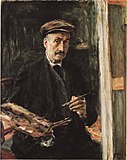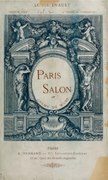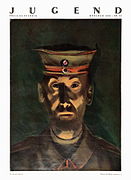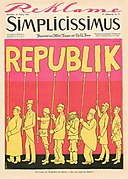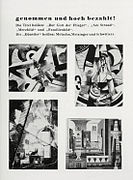Secession (art)
In art history, secession refers to a historic break between a group of avant-garde artists and conservative European standard-bearers of academic and official art in the late 19th and early 20th century.[1] The name was first suggested by Georg Hirth (1841–1916),[2] the editor and publisher of the influential German art magazine Jugend (Youth), which also went on to lend its name to the Jugendstil. His word choice emphasized the tumultuous rejection of legacy art while it was being reimagined.[3][4][5]
Of the various secessions, the Vienna Secession (1897) remains the most influential. Led by Gustav Klimt, who favored the ornate Art Nouveau style over the prevailing styles of the time,[4] it was inspired by the Munich Secession (1892), and the nearly contemporaneous Berlin Secession (1898), all of which begot the term Sezessionstil, or "Secession style."[4]
Hans-Ulrich Simon later revisited that idea in Sezessionismus: Kunstgewerbe in literarischer und bildender Kunst, the thesis he published in 1976.[6] Simon argued that the successive waves of art secessions in the late 19th and early 20th century Europe collectively form a movement best described by the all-encompassing term "Secessionism."
By convention, the term is usually restricted to one of several secessions — mainly in Germany, but also in Austria and France — coinciding with the end of the
Artists and their art
The Vienna Secession, founded in 1897, is the most famous of these groups. Although the Austrian Gustav Klimt is one of its most well-known members, the group also included Czech Alphonse Mucha, Croatian sculptor Ivan Mestrovic and the Polish artists Jozef Mehoffer, Jacek Malczewski and Stanislaw Wyspianski,[11] the latter of whom were invited to join the Secession in its opening year, as well as write for Ver Sacrum, the Secession magazine Klimt founded, which spread the influence of Art Nouveau.[11] Curvilinear geometric shapes and patterns of that period are typical of it. Artists reveled in the movement's broad visual vocabulary. Their work spanned the arts — painting, decor, architecture, graphic design, furniture, ceramics, glassware and jewelry — at times naturalistic, at times stylized.[4]
Founded in 1919, the
In 1937, while planning a major exhibition of "pure" art,
In 1945, the last year of World War II, the British and American
Portraits
(Selection was limited by availability.)
-
French painter Pierre Puvis de Chavannes (1824–1898) c. 1880. → Société Nationale des Beaux-Arts
-
German painter, sculptor, printmaker, and architectFranz Stuck(1863–1928) self-portrait, 1923. → Munich Secession
-
Lovis Corinth (1858-1925) portrait of German painter and graphic artist Otto Eckmann (1865–1902), painted in 1897. → Jugendstil
-
German painter Max Liebermann (1847–1935), painted in 1925. → Berliner Secession
-
Austrian painter Egon Schiele (1890–1918) self-portrait from 1910. → Sonderbund westdeutscher Kunstfreunde und Künstler
-
Portrait of German painter and printmaker Otto Dix (1891–1969) by Hugo Erfurth, c. 1933. → Dresden Secession
Movements
Société Nationale des Beaux-Arts
Paris (1890–present) — Known for its role in decisively ending the stranglehold the state had on the salon exhibition system, the rebel Société Nationale des Beaux-Arts formed in reaction to the Société des artists français.[20] The revolt led by Puvis de Chavannes, Ernest Meissonier, Carolus-Duran and Carrier-Belleuse helped radicalize the Central European art world.
The Munich Secession
The Jugendstil (Youth Style)
Munich, Weimar and Germany's Darmstadt Artists' Colony (1895–1910) — They were formed to resist the official and academic emphasis on
The Vienna Secession
Vienna (1897–1905) — The most famous secession was the Vienna Secession formed in reaction to the Association of Austrian Artists. Leading figures included Gustav Klimt, Josef Hoffman, Koloman Moser and Otto Wagner. They are known for their painting, furniture, glass and ceramics, as well as the Secession Building the architect Joseph Maria Olbrich's designed in Vienna, and the magazine Ver Sacrum, founded by Klimt.
The Berlin Secession
Berlin (1899–1913) — The Berlin Secession formed in reaction to the Association of Berlin Artists, and the restrictions on contemporary art imposed by Kaiser Wilhelm II, 65 artists "seceded" to create and exhibit new work, sometimes linked by terms like "Berlin Impressionism," or "German Post-Impressionism," in both cases reflecting the influence of French Impressionism, which had spread internationally.[8] They are also known for their conceptual art, as well as an internal split in the group which led to the formation of a New Secession (1910–1914). Key figures included Walter Leistikow, Franz Skarbina, Max Liebermann, Hermann Struck, and the Norwegian painter Edvard Munch.[8][22][23]
The Sonderbund westdeutscher Kunstfreunde und Künstler
Cologne (1909–1916) — Also known as the "Sonderbund" or the "Separate League of West German Art Lovers and Artists," the
The Dresden Secession
Dresden (1919–1925) — Formed in reaction to the oppression of post World War I and the rise of the Weimar Republic,
Periodicals
(Selection was limited by availability.)
-
Société Nationale des Beaux-Arts — A Salon de Champ-de-Mars catalogue, noting that one catalogue a year, of two, would be dedicated to work from the new Paris Salon, 1893.
-
Vienna Secession — Alfred Roller's cover for the January issue of Ver Sacrum magazine, 1898.
-
Munich Secession — Franz von Stuck's cover illustration for Pan (magazine), April/May 1895.
-
Jugendstil — Konrad Westermayr's painting "Self-Portrait with Field Cap," published on the cover of issue 32 of "Jugend" magazine in 1930.
-
Munich Secession — Historical cartoon despicting the Weimar Republic as a 'republic without republicans.' Published in the politically daring and visually modern magazine Simplicissimus on 21 March 1927.
-
The Weimar Republic — Degenerate Art (Entartete Kunst) exhibition catalogue, showing work by Johannes Molzahn, Jean Metzinger, and Kurt Schwitters in 1937.
See also
- Academic art – Style of painting and sculpture
- Pre-Raphaelite– Group of English painters, poets and critics, founded in 1848Pages displaying short descriptions of redirect targets
- Salon des Refusés Art exhibition in Paris, first held in 1863, of works rejected by the Académie des Beaux-Arts
References
- ^ a b c d e "Munich Secession: Avant-Garde Artists Association". www.visual-arts-cork.com. Retrieved 2021-01-16.
- JSTOR 878545.
- ^ a b Danzker, Jo-Anne Birnie. "The Munich Secession Demystified". Frye Art Museum. Archived from the original on 2022-05-24. Retrieved 2021-01-12.
- ^ a b c d Rosenman, Roberto (2017). "The Vienna Secession: A History". The Vienna Secession. Retrieved 2021-01-11.
- ^ "The illustrated guide to Helsinki's Art Nouveau and Jugendstil architecture". Helsinki Jugendstil. Retrieved January 11, 2021.
- ^ "Sezessionismus. Kunstgewerbe in literarischer und bildender Kunst. von Simon, Hans-Ulrich.: (1976) | Georg Fritsch Antiquariat". www.zvab.com. Retrieved 2021-01-12.
- ^ "Industrial Revolution | Definition, History, Dates, Summary, & Facts". Encyclopedia Britannica. Retrieved 2021-01-18.
- ^ a b c d e "The Artist Hermann Struck and His Work: From the Berlin Secession to the Landscapes of Israel". web.nli.org.il. 25 February 2017. Retrieved 2021-01-11.
- ^ "The Champ de Mars massacre". French Revolution. 2020-08-31. Retrieved 2021-01-19.
- ^ a b "Paris Salon". www.visual-arts-cork.com. Retrieved 2021-01-19.
- ^ a b "Polish Art Nouveau | Mloda Polska". www.local-life.com. Retrieved 2021-01-19.
- ^ ISSN 0362-4331. Retrieved 2021-01-16.
- ^ a b Schjeldahl, Peter. "Dark Pleasures". The New Yorker. Retrieved 2021-01-16.
- ^ a b Holocaust Encyclopedia. ""Degenerate" Art". United States Holocaust Memorial Museum. Retrieved 2021-01-12.
- ^ a b c d Budanovic, Nikola (2018-01-27). "Degenerate Art Exhibition - When Hitler Declared War on Modern Art". WAR HISTORY ONLINE. Retrieved 2021-01-19.
- ^ a b Filkins, Dexter. "Inside the U.S. Army's Warehouse Full of Nazi Art". The New Yorker. Retrieved 2021-01-16.
- ^ a b c O'Connor, William (2014-11-30). "The Modern Artists the Nazis Favored". The Daily Beast. Retrieved 2021-01-19.
- ^ a b Michalska, Magda (2016-08-27). "4 Of Hitler's Least Favourite 'Degenerate' Artists (There Were Many More)". DailyArtMagazine.com - Art History Stories. Retrieved 2021-01-19.
- JSTOR 858498.
- ^ "Paris Salons (1673–present)". The Art Institute of Chicago. Retrieved 2021-01-11.
- ^ a b c "Jugendstil Movement Overview". The Art Story. Retrieved 2021-01-22.
- ^ Nationalgalerie, Staatliche Museen zu Berlin. "Berlin Impressionism: Works from the Berlin Secession from the National Gallery in Berlin" (PDF). GDKE Berliner Impressionisten.
- ^ "Post-Impressionism in Germany (1880-1910)". www.visual-arts-cork.com. Retrieved 2021-01-22.
- ^ Willette, Jeanne. "German Expressionism | Art History Unstuffed". Retrieved 2021-01-22.
- ^ a b c Welle (www.dw.com), Deutsche. "1912 show that shook art world returns to Cologne | DW | 20.09.2012". DW.COM. Retrieved 2021-01-22.
Bibliography
- Simon, Hans-Ulrich: Sezessionismus. Kunstgewerbe in literarischer und bildender Kunst, J. B. Metzlersche Verlagsbuchhandlung, Stuttgart 1976 ISBN 3-476-00289-6





